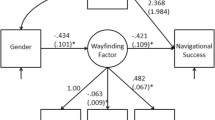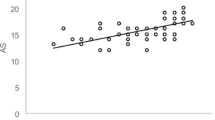Abstract
The current study assessed potential relationships among childhood wayfinding experience, navigational style, and adult wayfinding anxiety in the Faroe Islands. The Faroe Islands are of interest because they have an unusual geography that may promote the use of an orientational style of navigation (e.g., use of cardinal directions). Faroese adults completed questionnaires assessing (1) their permitted childhood range sizes, (2) the types of navigational strategies they use, and (3) the amount of anxiety they experience when navigating in adulthood. Males had more childhood wayfinding experience, used the orientation strategy at a higher rate, and showed lower levels of wayfinding anxiety. When compared with other cultures, both Faroese women and men appear to embrace orientation strategies at an unusually high rate. Childhood experience was not conclusively linked to later wayfinding anxiety. However, the current findings raise the possibility that children who have particularly small ranges in childhood may be especially anxious when navigating in adulthood.


Similar content being viewed by others
Notes
By asking about what children were allowed to do, the current study addressed the specific question of parental permissiveness. However, the phrasing left open the possibility that children might have roamed much further without permission. This intriguing possibility is worth exploring further; however, previous research suggests that, in childhood, permitted ranges are very similar to total ranges (Herman et al. 1987). See also Hart 1979 for related sex differences.
Lawton and Kallai’s sample consisted of 423 Americans (274 female) and 263 Hungarians (140 female). The original data were not available for direct statistical comparison. Therefore, comparisons are based only on the publicly available means and standard deviations.
References
Baenninger, M., & Newcombe, N. (1989). The role of experience in spatial test performance: a meta-analysis. Sex Roles, 20(5–6), 327–344.
Coluccia, E., & Louse, G. (2004). Gender differences in spatial orientation: a review. Journal of Environmental Psychology, 24(3), 329–340.
Feng, J., Spence, I., & Pratt, J. (2007). Playing an action video game reduces gender differences in spatial cognition. Psychological Science, 18(10), 850–855.
Føroya, H. (2014). Faroe Islands in figures, 2014. Retrieved from http://www.hagstova.fo/sites/default/files/Faroe%20Islands%20in%20figures%202014_0.pdf.
Fyhri, A., Hjorthol, R., Mackett, R. L., Fotel, T. N., & Kyttä, M. (2011). Children's active travel and independent mobility in four countries: development, social contributing trends and measures. Transport Policy, 18(5), 703–710.
Gaffin, D. (1996). In place: spatial and social order in a Faeroe islands community. Prospect Heights, IL: Waveland Press.
Gaini, F. (2013). Lessons of islands: place and identity in the Faroe Islands. Fróðskapur: Faroe University Press.
Hart, R. (1979). Children's experience of place. New York: Irvington.
Herman, J. F., Heins, J. A., & Cohen, D. S. (1987). Children's spatial knowledge of their neighborhood environment. Journal of Applied Developmental Psychology, 8(1), 1–15.
Hillman, M., Adams, J., & Whitelegg, J. (1990). One false move: A study of children’s independent mobility. London: Policy Studies Institute.
Kyttä, M. (1997). Children’s independent mobility in urban, small town, and rural environments. In R. Cammstra (Ed.), Growing up in a changing urban landscape (pp. 41–52). Assen: Royal Van Gorcum.
Lawton, C. A. (1994). Gender differences in way-finding strategies: relationship to spatial ability and spatial anxiety. Sex Roles, 30(11–12), 765–779.
Lawton, C. A. (1996). Strategies for indoor wayfinding: the role of orientation. Journal of Environmental Psychology, 16(2), 137–145.
Lawton, C. A., & Kallai, J. (2002). Gender differences in wayfinding strategies and anxiety about wayfinding: a cross-cultural comparison. Sex Roles, 47(9–10), 389–401.
LeMoyne, T., & Buchanan, T. (2011). Does “hovering” matter? Helicopter parenting and its effect on well-being. Sociological Spectrum, 31(4), 399–418.
Massa, L. J., Mayer, R. E., & Bohon, L. M. (2005). Individual differences in gender role beliefs influence spatial ability test performance. Learning and Individual Differences, 15(2), 99–111.
Matthews, M. H. (1987). Gender, home range and environmental cognition. Transactions of the Institute of British Geographers, 12, 43–56.
Miller, D. I., & Halpern, D. F. (2014). The new science of cognitive sex differences. Trends in Cognitive Sciences, 18(1), 37–45.
Mitra, R., Faulkner, G. E., Buliung, R. N., & Stone, M. R. (2014). Do parental perceptions of the neighbourhood environment influence children’s independent mobility? Evidence from Toronto, Canada. Urban Studies, 51(16), 3401–3419.
Moè, A. (2009). Are males always better than females in mental rotation? Exploring a gender belief explanation. Learning and Individual Differences, 19(1), 21–27.
Munroe, R. L., & Munroe, R. H. (1971). Effect of environmental experience on spatial ability in an East African society. The Journal of Social Psychology, 83(1), 15–22.
Nerlove, S. B., Munroe, R. H., & Munroe, R. L. (1971). Effect of environmental experience on spatial ability: a replication. The Journal of Social Psychology, 84(1), 3–10.
O'Brien, M., Jones, D., Sloan, D., & Rustin, M. (2000). Children's independent spatial mobility in the urban public realm. Childhood, 7(3), 257–277.
Prezza, M. (2007). Children's independent mobility: a review of recent Italian literature. Children, Youth and Environments, 17(4), 293–318.
Prezza, M., Alparone, F. R., Cristallo, C., & Luigi, S. (2005). Parental perception of social risk and of positive potentiality of outdoor autonomy for children: the development of two instruments. Journal of Environmental Psychology, 25(4), 437–453.
Prezza, M., Pilloni, S., Morabito, C., Sersante, C., Alparone, F. R., & Giuliani, M. V. (2001). The influence of psychosocial and environmental factors on children's independent mobility and relationship to peer frequentation. Journal of Community and Applied Social Psychology, 11(6), 435–450.
Rissotto, A., & Tonucci, F. (2002). Freedom of movement and environmental knowledge in elementary school children. Journal of Environmental Psychology, 22(1), 65–77.
Rose, K. A., Morgan, I. G., Ip, J., Kifley, A., Huynh, S., Smith, W., & Mitchell, P. (2008). Outdoor activity reduces the prevalence of myopia in children. Ophthalmology, 115(8), 1279–1285.
Sandseter, E. B. H., & Kennair, L. E. O. (2011). Children’s risky play from an evolutionary perspective: the anti-phobic effects of thrilling experiences. Evolutionary Psychology, 9(2), 257–284.
Schmitz, S. (1997). Gender-related strategies in environmental development: effects of anxiety on wayfinding in and representation of a three-dimensional maze. Journal of Environmental Psychology, 17(3), 215–228.
Schug, M. G. (2016). Equal children play best: raising independent Faroese children in the Nordic welfare state. In J. DeLoache, & A. Gottlieb (Eds.), World of babies: imagined childcare guides for nine societies. Cambridge: Cambridge University Press (in press).
Segrin, C., Woszidlo, A., Givertz, M., & Montgomery, N. (2013). Parent and child traits associated with overparenting. Journal of Social and Clinical Psychology, 32(6), 569–595.
Silverman, I., Choi, J., & Peters, M. (2007). The hunter-gatherer theory of sex differences in spatial abilities: data from 40 countries. Archives of Sexual Behavior, 36(2), 261–268.
United Nations Statistics Division (2008). Demographic statistics. Retrieved from http://data.un.org/Data.aspx?d=POPandf=tableCode%3A240
Uttal, D. H., Meadow, N. G., Tipton, E., Hand, L. L., Alden, A. R., Warren, C., & Newcombe, N. S. (2013). The malleability of spatial skills: a meta-analysis of training studies. Psychological Bulletin, 139(2), 352–402.
Villanueva, K., Giles-Corti, B., Bulsara, M., McCormack, G. R., Timperio, A., et al. (2012). How far do children travel from their homes? Exploring children's activity spaces in their neighborhood. Health and Place, 18(2), 263–273.
Webley, P. (1981). Sex differences in home range and cognitive maps in eight-year-old children. Journal of Environmental Psychology, 1(4), 293–302.
Acknowledgments
I thank the Spatial Cognition and Navigation Project for their funding (National Science Foundation IBSS 1329091), my local contact Eiler Fagraklett for his assistance with data collection, and Luke Ayers for his technical support.
Author information
Authors and Affiliations
Corresponding author
Rights and permissions
About this article
Cite this article
Schug, M.G. Geographical Cues and Developmental Exposure. Hum Nat 27, 68–81 (2016). https://doi.org/10.1007/s12110-015-9245-4
Published:
Issue Date:
DOI: https://doi.org/10.1007/s12110-015-9245-4




